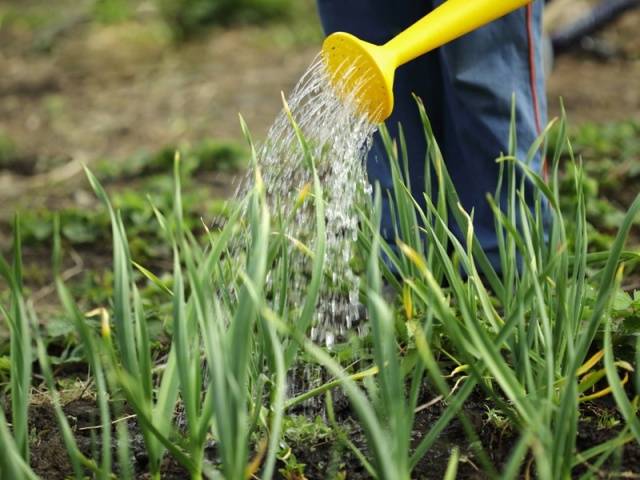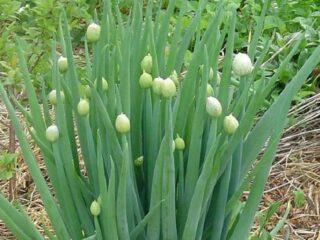Content
Probably all summer residents of Russia, without exception, grow onions. Not only is this garden crop very unpretentious, but onions are also very important - it is impossible to imagine almost any popular dish without it, besides, the vegetable contains a lot of vitamins and is necessary for the body to strengthen the immune system. Despite the simplicity of the process, gardeners often ask the question: “Am I growing onions correctly, or can something be done to make the harvest even better and the bulbs larger?”
About, how to plant onions in open ground and how to care for it, as well as how to grow large onions at your own dacha, you can learn from this article.
Features of culture
The most common type of onion crop is the onion. This vegetable has a spherical, slightly flattened or elongated shape; its scales can be colored red, orange or white. Depending on this, the taste of onions differs, as follows:
- red onion – sweet;
- orange – spicy;
- white – semi-sweet.
First of all, the gardener must decide on the variety of vegetable crop.Varieties of onions, as a rule, are zoned, among them you can find species intended for winter cultivation, varieties of onions that are planted directly from seeds and other varieties.
The culture is propagated by seeds, which ripen in umbellate inflorescences on thick and long stems. These stems are called arrows; in ordinary growing onions They try to prevent bolting on the head by any means. This is due to the fact that the flowering plant will not produce a strong and large bulb - the harvest will be spoiled.
Onion seeds are black in color and have a round or slightly pointed shape. In the first year, nigella is sown in the ground, from which sets grow - small onions, about one centimeter in diameter. To get full-fledged bulbs, you need to plant this set next season.
When and how to plant onions in open ground
First of all, you need to decide when to plant onions in the garden. This should definitely be done only when the soil at the dacha has warmed up to at least 12 degrees.
If you plant or sow onions in cold soil, this will inevitably lead to bolting of the plants and a deterioration in the crop yield subsequently.
In most regions of the country, onions are planted in garden beds in the spring, usually this happens in early May. However, there is also a winter method of growing this crop, which is often used by experienced farmers - it will also be discussed in the article.
The method of growing onions in open ground largely depends on the climatic characteristics of the region, the duration of summer, average temperature and other weather factors.
Depending on this, growing onions can be done in several ways:
- Planting onions with seeds - growing onions in an annual crop.
- A method for sowing nigella seedlings and then replanting them in open ground.
- Growing in a two-year culture - first, nigella is sown, then the resulting set is planted to obtain large bulbs.
All these methods have their own characteristics, so it is worth familiarizing yourself with them in more detail.
How to grow onions from nigella
Only those summer residents who live in the southern regions of Russia, with long and hot summers, can grow onions as an annual crop.
To preserve high-quality seedlings until spring, you have to provide them with suitable temperature and humidity conditions, regularly discard damaged bulbs, etc.
Among onion varieties, sweet and semi-sweet crops are most suitable for annual cultivation., which, as a rule, are distinguished by red or white husks. It is these bulbs in the form of sets that are the worst preserved during the winter storage stage. In order to save planting material, gardeners try to grow such varieties in one year - directly from seeds.
They do it like this:
- soak nigella or place it in a damp cloth for a couple of days;
- prepare the beds, fertilizing them with complex mineral fertilizers;
- water the ground with a solution of copper sulfate or potassium permanganate;
- make holes about 1.5-2 cm deep, maintaining a distance between rows of approximately 13-15 cm;
- sow nigella;
- water the rows from a watering can through a divider;
- cover the plantings with thick plastic film;
- when the greens hatch, remove the film;
- now you need to thin out the crops, leaving 2-3 cm between plants;
- It is better to mulch the area with rotted humus to prevent the soil from drying out and the appearance of weed;
- After 2-3 weeks, thinning is repeated, the final interval between plants should be 6-8 cm.
It will not be possible to grow very large onions this way, but with proper care, sufficient fertilizer and watering, and if you can prevent fungal diseases and eliminate crop pests, you can grow quite a decent crop from seeds.
The most important thing is that you can do this in just one season and not spend money on buying seedlings.
How to grow onions in open ground from seedlings
The seedling method is rarely used when growing such a simple crop as onions. However, this option is most suitable for some valuable and rare varieties of crops, because the seeds of such plants can be very expensive - the task of the summer resident is to preserve the planting material as much as possible.
The painstaking process of growing onion seedlings is in many ways similar to the seedling cultivation of other garden crops. First of all, you need to prepare the substrate; nutritious, slightly acidic soils with good air permeability are more suitable for nigella.
The earth is poured into boxes and grooves are made, about 1 cm deep. The distance between the rows should be about 4-5 cm. Onion seeds must be sown 50-60 days before the seedlings are to be transferred to open ground. The seeds are sown thickly; as the plants grow, they need to be thinned out so that they are strong and tall.
Onion seedlings, in principle, tolerate transplantation well, quickly acclimatize and take root in a new place.
How to grow a good harvest of onions the traditional way
Traditionally and more often, onions are grown as a two-year crop: in the first year, nigella is sown and small heads - sets - are collected at the end of the season; in the second spring, sets are planted in the soil, and large onions - turnips - are harvested.
The main task of the gardener with this method of growing crops is to preserve as much planting material as possible. Store the sets Onion crops need to be grown in a cool and dark place with a constant level of humidity. Periodically, the bulbs are inspected and spoiled or rotten heads are removed so that they do not infect the rest of the material.
A few weeks before planting, onions are brought into the house. To prevent the crop from sprouting, the seedlings need to be thoroughly warmed up.
To do this, the bulbs are sorted and placed in a dry and warm place, with a temperature of at least 25 degrees.
Warmed bulbs must be disinfected. For these purposes, you can use the solution:
- table salt;
- copper sulfate;
- potassium permanganate.
After processing, the bulbs are dried, now you can start planting. Plant onions in this way:
- The soil needs to be prepared in the fall. For onions, choose a well-lit area with nutritious soil of neutral acidity. The soil is fertilized with humus or compost and dug to the depth of a spade bayonet.
- In the spring, as soon as the snow melts and the ground dries out a little, you can apply mineral fertilizers and dig up the soil on the site again.
- The soil can be generously watered with copper sulfate dissolved in water; for more effective disinfection, the soil can be covered with film.
- 10-14 days after treatment, you can proceed to planting onions.
- First, make beds, keeping a distance of 25-35 cm between rows.
- The prepared bulbs are inserted into the ground with your fingers, pressing down slightly. The bulbs should not protrude above the surface of the soil, but the heads should not be immersed too much in the ground either.
- There is no need to water the beds immediately after planting. The first watering of onion plantings is carried out after two weeks.
What is onion care?
Onions, in principle, are a very unpretentious crop; all care for this vegetable consists of the following:
- Plants should be watered as needed, that is, when the soil between the rows becomes too dry. As a rule, this is once a week. But the frequency and extent of watering can vary significantly depending on weather conditions.
- In principle, there is no need to fertilize onions planted in nutritious soil. If the soil on the site has been fertilized with compost or humus since the fall, then in the spring the onion beds do not need to be fed. When the green mass grows too slowly, summer residents still use mineral components to feed the crop. This can be either purchased fertilizers or organic matter, for example, chicken droppings dissolved in water.
- Onions are afraid of fungal infections; to prevent their spread, you need to monitor the soil moisture.It is necessary to prevent infection of the crop by fungi by treating the onion beds with fungicidal agents. You also need to ensure that the onions are not attacked by midges or other dangerous pests.
How to grow winter onions
To a greater extent, due to the fact that onion sets are poorly stored and by spring gardeners usually lose most of their supplies of planting material, some farmers plant onions in the fall.
This method can be used both for sowing nigella and for planting onion sets. To get greens, it is enough to sow the seeds, and you will have to plant a set on the head. But for this measure to be effective, you need to choose suitable, cold-resistant varieties that can withstand Russian frosts.
You need to plant onions right before the onset of frost, but when the earth has not yet cooled too much. The most suitable time for planting in the central part of the country can be considered October 20-25.
Onions are planted according to the usual pattern, just like in the spring. When severe frosts begin, the plantings are covered with spruce branches or dry hay - this will protect the seeds from freezing.
In the spring, the cover is removed before the onset of heat, so that the onions do not trample. Choose for planting winter onions You need areas from which the snow melts early and the ground dries quickly under the sun's rays.
Growing and caring for onions is not particularly difficult - even inexperienced beginners can cope with this task. All that remains is to choose a variety and decide on the method of planting the crop - and a harvest of large bulbs is guaranteed. The following video will help gardeners:























